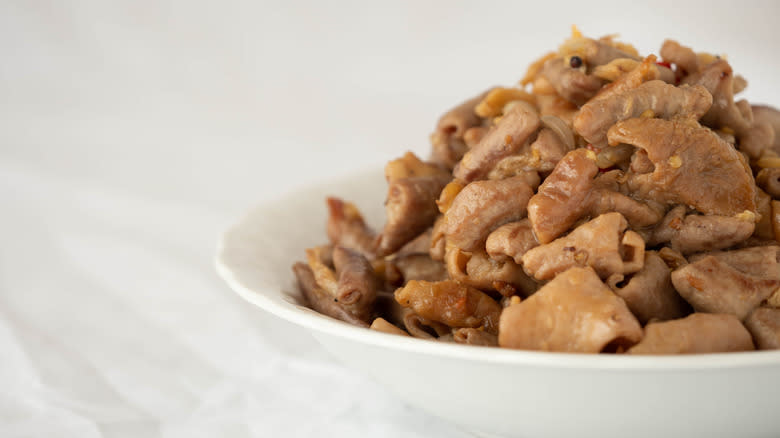The Only 2 Sauces You Need For Pork Chitterlings

In the U.S, organ pork cuts aren't frequently utilized -- except for in soul and cajun cuisines. A serving of well-prepared chitterlings, also called chitlins, showcases the delicious potential of an underutilized pork part, like the large intestine. First boiled in an aromatic selection of seasonings and then optionally fried, it's a meat that's crispy and delicious. And to accompany the tasty bites, it's typically served with hot sauce and vinegar.
The former adds a tantalizing dash of heat, invoking a flavorful punch of spice. The latter cuts through the cut's richness and adds a bright note to the palate. Plus, selecting from varying hot sauce and vinegar combinations grants malleability in the resultant balance of heat, acidity, and pork richness.
The combination of the two sauces with chitlins is historically founded in centuries-old soul food cuisine. Especially when accompanied by sides like cornbread, fried chicken, and collard greens, such a preparation showcases a traditional classic.
Read more: 13 Underrated Cuts Of Meat You Should Be Grilling
Pairing Pork Chitterlings With Hot Sauce Stems From Soul Food's Roots

The pairing of hot sauce, vinegar, and chitterlings traces back centuries. The crispy pork dish was eaten by Black Americans during slavery, especially due to its cost-effective nature. However, its roots lie further back in West African culinary tradition. There, nose-to-tail eating was historically integrated into local cuisine, along with a penchant for spicy food. Chilies from the New World were first incorporated into West African cuisine and later mingled with new food creations in the American South. As a method of preservation for these peppers, many types of vinegars arose. Created from leftover foods like apples or rye mash, they combined with a broad selection of peppers, resulting in a large variety of hot sauces.
Traditionally, the dish was served in the winter, when pigs were butchered. As a shelf-stable product, the consumption of hot sauce and vinegar could continue at this time of season. However, due to chitterlings' labor-intensive cleaning and cooking process, this dish lost some prevalence into the 20th century, reserved for restaurants and special occasions. Nevertheless, soul food eateries in the south still offer a tasty fix of the combination. On top of that, superfans of the dish can head to Salley, South Carolina, for the annual Chitlin' Strut festival.
Read the original article on Tasting Table.

